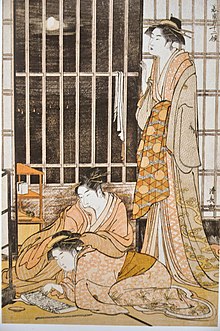Torii Kiyonaga

Torii Kiyonaga ( Japanese 鳥 居 清 長 ; * 1752 in Edo (today Tokyo ), † June 28, 1815 there ) is today one of the most important Japanese color woodcut artists of the 18th century.
introduction
Its original name was Sekiguchi Shinsuke ( 関口 新 助 ). He was born in Edo in 1752 and died there on June 28, 1815. He is considered one of the most important Japanese artists of the so-called Ukiyo-e movement, ie as a painter of paintings and woodcuts depicting the “flowing, transitory world”. He was a student of Torii Kiyomitsu and ran the famous Torii school for a while .
Career advancement
The famous painter Kiyonaga was influenced by the woodcut artists Suzuki Harunobu , Isoda Koryūsai, and Kitao Shigemasa . He was the son of a bookseller and learned the woodcut painting trade from Torii Kiyomitsu. Although he worked strictly in the tradition of the Torii school and was fully aware of his responsibility as a teacher, he not only created woodcuts in the kabuki theater subjects taught by his school , but also created his greatest works just by breaking away from this traditional painting tradition . Under his aegis, the image of the theater and its protagonists in particular was permeated with new stimuli and led to masterful climaxes.
Highlights of his creativity
Absolutely masterful and world famous in art history are his woodcuts of elegant, young people, graceful girls and courtesans , which appear in front of clearly contrasting backgrounds, which mostly show his beloved hometown Edo. His solid technical training enabled him to create a new style that had an absolutely defining effect on other artists for about twenty years. He leaned clearly on the early days of ukiyo-e and executed poetic and beguiling-looking pictures with his realistic drafting power.
Later years
His pictures also had an exemplary and style-forming effect on Utamaro . However, when Utamaro's own, somewhat more pleasant style developed, it became exemplary for the younger woodcut artists. From now on, Kiyonaga limited himself to theater and actor performances. Only a few woodcuts have survived from the last twenty years of his life.
Individual evidence
- ^ Encyclopedia Britannica 2009
- ^ Richard Lane: Images from the floating world. The japanese print. New York 1978. p. 288.
Web links
| personal data | |
|---|---|
| SURNAME | Torii, Kiyonaga |
| ALTERNATIVE NAMES | 鳥 居 清 長 (Japanese); Sekiguchi Shinsuke (real name); 関口 新 助 (Japanese, real name) |
| BRIEF DESCRIPTION | Japanese artist |
| DATE OF BIRTH | 1752 |
| PLACE OF BIRTH | Edo (now Tokyo ) |
| DATE OF DEATH | June 28, 1815 |
| Place of death | Edo (now Tokyo ) |